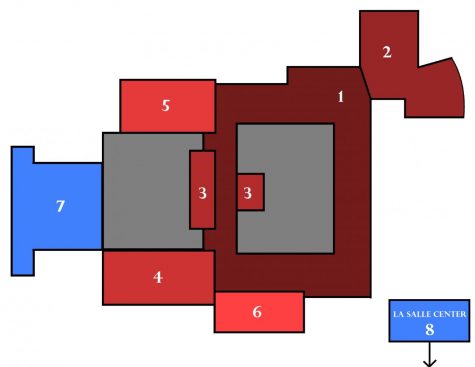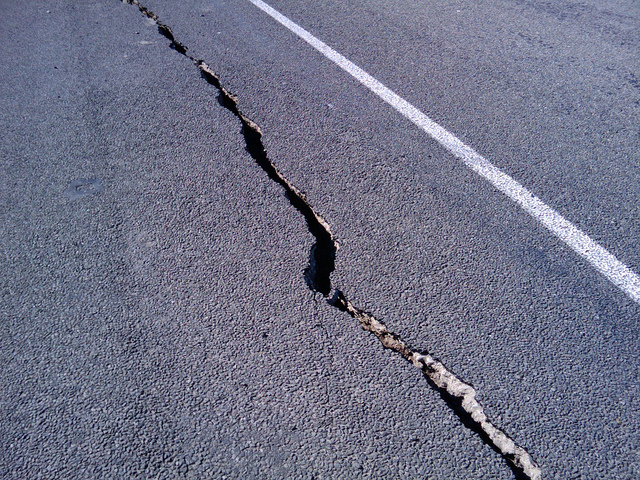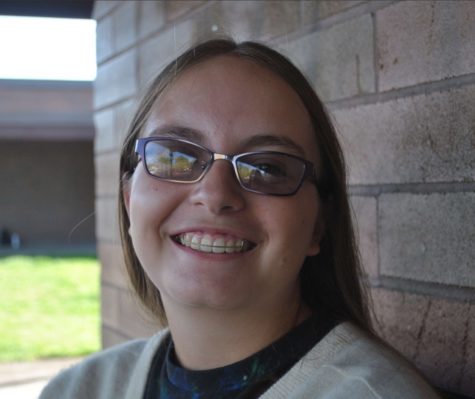Massive Earthquake Threat Prompts La Salle to Prepare
May 12, 2017
It’s hard to ignore the fact that there’s a one in five chance that a devastating 8.0 magnitude earthquake will shake the Pacific Northwest in the next 50 years (to learn more, read our previous article about this threat). One of the most important ways to prepare for an earthquake is to create an earthquake preparedness kit, while also making sure that other preparedness steps have been taken, which raises the question: What has La Salle done to prepare?
Students spend a minimum of seven hours at school every day, but many have zero period classes before school or sports practice for hours after school, and even more stay after school to do homework. Taking this into consideration, it’s very possible that an earthquake could strike during the school day or when hundreds of students are on campus. But what would happen? Would we have food? Water? Shelter? Is there any sort of plan? We went to La Salle’s Matthew Winningham, Vice President of Finance and Operations, and Brian Devine, Vice Principal for Student Life, to ask them to share more about the school’s plans to prepare for an earthquake.
La Salle was built in the 1960’s primarily with reinforced brick, and it has been consistently updated since then to meet seismic codes.
“It’s a solid structure to begin with, so we’re thankful for that,” Mr. Winningham said. “When we redo roofs throughout the school, we do any seismic upgrade, at least to code, but we try to maximize our ability to do that. Cost is always a factor, but we try to make sure we’re doing the best we can to create a sound environment.”
Check out our map of La Salle, and the accompanying description of each location’s structural integrity, according to Mr. Winningham:

- Academic Hallways and Classrooms: Redone in 2001, the retrofitted brick was made to match the seismic codes of the time. HVAC (Heating, Ventilation, and Air Conditioning) units were added with structural reinforcements around them. They could pose the biggest risk in classrooms, due to the fact that they are large, heavy, and dangerous if they fall. However, the structural reinforcements will help to keep these in place during an earthquake.
- Library and Science Wing: In 2003, the library and science wing were added. Since they were built new and not retrofitted, these structures are very safe.
- Chapel, Director of Admissions Office, and Conference Room: The roof was redone in 2007 to match seismic codes.
- Theater: Redone in 2011. There was very little new work that had to be done to make it structurally sound, but it is up to date with seismic standards. There are hopes to redo the roof at some point.
- Cafeteria: Seismic reinforcing was done in 2013 to match the codes of the time. “We weren’t required to do that,” said Mr. Winningham, “but… we want to meet as close as we can the new construction codes.”
- Lobby and Administrative Wing: Built in 2016, this is a mixture of new construction and retrofitting, which makes it a safe area in an earthquake.
- Gym: This is a brick building, and there is a plan to redo the roof and add additional seismic retrofitting in the next few years. According to Mr. Winningham, “We feel comfortable… but the gym would be the next area. [We will do] everything we can do to make that as structurally sound as possible. That’s our next big step that we have in mind.”
- La Salle Center: Nothing has been done to the La Salle Center recently, but any damage would probably be to property, not people. There will be roof replacements in the future.
Overall, the areas where students usually spend their time – what Mr. Winningham called “the cell of the school” – are safe. “We feel like we’ve given everything we can to be responsible in terms of providing for the safety of our students,” Mr. Winningham said.
The supplies that would be needed to deal with an earthquake are still being assembled. Every classroom has a Go Bag, containing a first aid kit, flashlight, blanket, and cold packs. The cafeteria generally has enough food and water to support students for one day – but experts recommend to have enough food and water for at least three days, a staggering amount of total resources needed, when considering the 800+ people on campus each day.
However, Mr. Devine says that there is a plan in place to purchase enough food and water this summer to support the school for several days. The problem with having so many emergency supplies on hand is finding a place to store it, but Mr. Devine said that those supplies would be kept in an outside storage space.
There is also a possible area for students to gather for shelter: beyond the tennis court is an outbuilding made with pole barn construction that could be used, if necessary. According to the Pole Barn Company, pole barns are very sturdy, and an outbuilding could be used as a place to shelter students after an earthquake. “It’s not enclosed, but it’s a covered area that we might be able to use as a congregating space,” Mr. Winningham said. “It’s a decent effort towards making sure that people have the basic needs until we can get them to their families.”
Earthquakes are unpredictable and dangerous, but Mr. Devine has outlined a plan for how students and staff should respond. While the earthquake is happening, it is important to stay safe by ducking under tables that are away from windows, bookshelves, and cabinets. Even after the initial tremors end, there are aftershocks that you should be prepared for – aftershocks can sometimes be stronger than the actual quake. If you’re outside, you should move to a place away from buildings, trees, poles, and power lines. Teachers will lead their classes to designated areas and immediately take roll, and the general structure will be “just like a fire drill,” said Mr. Winningham.
The school administration will assess the situation, make sure all students are accounted for, and make sure first aid is administered as necessary. After that, it will be decided whether or not students should be released to their homes.
As it stands, there is not enough food or water at La Salle to support the whole student body for an extended period of time. While supplies will be purchased, the administration still plans to send students to their homes if “safe and necessary.” Mr. Devine stated that there was a plan to safely release students, and Mr. Winningham agreed with that by stating that there would be “an orderly checkout process.”
“We want to keep it orderly and make sure that our kids and community are safe,” said Mr. Winningham.
One problem that the administration has anticipated is the population that surrounds the school, especially Christ the King and the different houses around La Salle, will likely also be in need of support in the aftermath of a major earthquake. Although there is not a plan to supply anyone outside of La Salle with food, water, or significant shelter, the school is open to the idea of providing some access to the campus to the general community. Mr. Winningham said that the “the goal… would be to just make sure they have a safe, flat space to be until they get their lives in order.”
It is impossible to say what would happen exactly after an earthquake, since there is no way of telling how much damage will be done, but Mr. Winningham says the school has taken many steps to increase the likelihood of being able to rebound quickly.
“We do have some financial protection through insurance called business interruption insurance” said Mr. Winningham. “That will help us – it’s not going to provide years worth of funding, but it’s going to help us survive as an organization through a process of massive interruption.”
Preparations for an earthquake are not yet finished. As mentioned, there will be food and water purchased over the summer, and there are plans in place to continue to improve the seismic stability of the few remaining vulnerable areas like the gym. Early next year, the school also plans to communicate and fully rehearse the evacuation plan with the students of La Salle.
“We feel like we’re going to do the best we can to protect our students after an event that occurs,” Mr. Winningham said. “You know, we can’t control when or how or how much, but after that occurs, it’s our job to make sure people feel safe, they’re protected, and that we are still a school that is going to try to make sure that every last one of our students and staff are accounted for and safely reunited with their families before our job is done.”
***
What do you think about La Salle’s earthquake preparedness efforts? What questions do you have? Let us know in the comments below!
Creative Commons photo source: https://www.flickr.com/photos/digitalsadhu/4955742902/






Katie Quines • May 17, 2017 at 11:37 pm
Excellent article Isadora. It was fascinating to learn about where the weak spots are in the building’s structure. It’s good to know that La Salle is taking steps to fix these issues, since I think earthquake preparedness is just as important as fire preparedness in the PNW.